Sabbatical in Sweden
Wednesday, November 15, 2006
Tuesday, November 14, 2006
 Early on we were told that Week 44 was a school vacation week, so we decided to take this opportunity to go on a family vacation. The local travel agencies have many standard packages for vacations from
Early on we were told that Week 44 was a school vacation week, so we decided to take this opportunity to go on a family vacation. The local travel agencies have many standard packages for vacations from 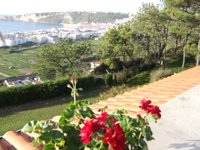 After learning to fasten our seatbelts and put our tray tables in the upright and locked position in English, Danish, Dutch and Portuguese, we finally we arrived in
After learning to fasten our seatbelts and put our tray tables in the upright and locked position in English, Danish, Dutch and Portuguese, we finally we arrived in
We had planned to travel around 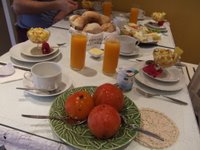 didn’t have the rest of our trip planned. Their place, Quinta das Rosas, was wonderful, with a vista of the
didn’t have the rest of our trip planned. Their place, Quinta das Rosas, was wonderful, with a vista of the
Breakfasts were lovely, served in a sun-drenched dining room, setting a standard not met later in the trip: fresh bread, local cheese, cocoa, coffee, fresh juice from the B&B’s own trees, eggs from their chickens, persimmons from a friend’s grove, etc. (We are glad we told them we don’t eat meat, especially since we got to be good friends with the donkey.)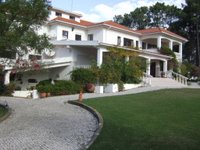
The B&B house, an elegant three-story villa, was built by the hostess’ father by hand about 20 years ago. He had a little help with things like pouring the foundation, but he did essentially everything including beautiful cabinetry, wood stairs, and the ceramic tiling himself.
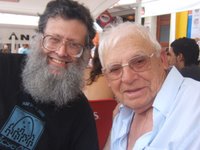 David spent time with Evangelino, the man responsible for the B&B construction, while Cathy and the kids went body surfing. When he was 28, Evangelino left Nazaré for
David spent time with Evangelino, the man responsible for the B&B construction, while Cathy and the kids went body surfing. When he was 28, Evangelino left Nazaré for
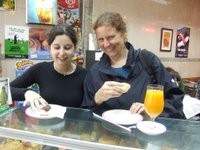 Sitting and drinking coffee in the plaza let us see some reminders of the
Sitting and drinking coffee in the plaza let us see some reminders of the
Our first night we ate dinner at a marina, sitting 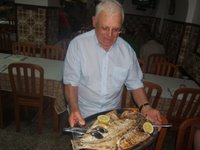 outside on the dock with local wine, fresh orange juice, and sangria until the fish restaurant opened at 7PM. We enjoyed the sunset and ordered “the fresh fish” (the owner’s English was fine, but all he could tell us was “it’s the fresh fish”). The next night we went to a fish restaurant that Evangelino recommended – he must have really liked this restaurant, since he showed up with his friends later in the evening. Again, the restaurant didn’t open until 7PM, so we wandered around the plaza, had some coffee, and watched a group of visiting nuns gather in the setting sun for a picture in front of the cathedral on top of the hill. A few minutes after we sat down for dinner, a couple of fishermen with a cooler walked into the restaurant. We could see into the kitchen and watched the unloading of “the fresh fish”. Soon after, the waiter introduced us to our dinner, which was then taken outside and grilled on a wood fire by a stone-faced woman.
outside on the dock with local wine, fresh orange juice, and sangria until the fish restaurant opened at 7PM. We enjoyed the sunset and ordered “the fresh fish” (the owner’s English was fine, but all he could tell us was “it’s the fresh fish”). The next night we went to a fish restaurant that Evangelino recommended – he must have really liked this restaurant, since he showed up with his friends later in the evening. Again, the restaurant didn’t open until 7PM, so we wandered around the plaza, had some coffee, and watched a group of visiting nuns gather in the setting sun for a picture in front of the cathedral on top of the hill. A few minutes after we sat down for dinner, a couple of fishermen with a cooler walked into the restaurant. We could see into the kitchen and watched the unloading of “the fresh fish”. Soon after, the waiter introduced us to our dinner, which was then taken outside and grilled on a wood fire by a stone-faced woman.
During our first day in Nazaré we went to the beach. The water was a bit chilly but there were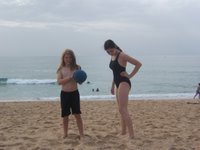 nice waves for body surfing, and the warm, rice-grained-size sand was perfect to cover Akiva. We also snuck looks a sunbathing man with the biggest nose we have ever seen; seriously, if George Bush had a schnoz that grew like Pinocchio's, it still wouldn't be noticeable next to this guy. Since it was a Sunday, the beach had a large number of families. In the summer apparently the beach is so crowded you literally need to rent a spot.
nice waves for body surfing, and the warm, rice-grained-size sand was perfect to cover Akiva. We also snuck looks a sunbathing man with the biggest nose we have ever seen; seriously, if George Bush had a schnoz that grew like Pinocchio's, it still wouldn't be noticeable next to this guy. Since it was a Sunday, the beach had a large number of families. In the summer apparently the beach is so crowded you literally need to rent a spot.
Cathy and Emma did a bit of shopping too. It turns out
The next morning we followed our B&B hosts to Alcobaça where they go to a fresh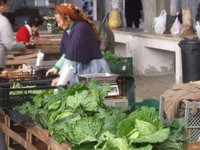 produce market. We stayed a while at the market admiring the cabbage and the sturdy Portuguese farmers, wondering what they did with the scads of massive cabbages for sale (since we didn't eat cabbage even once during the trip). We then walked over a small river bridge to the church in Alcobaça, the biggest church in
produce market. We stayed a while at the market admiring the cabbage and the sturdy Portuguese farmers, wondering what they did with the scads of massive cabbages for sale (since we didn't eat cabbage even once during the trip). We then walked over a small river bridge to the church in Alcobaça, the biggest church in 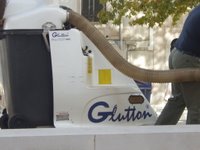
That day we also went to Caldas da Rainha which had been a spa town (no more alas) but that was now famous for pottery made to resemble fruits and vegetables – including more cabbages! Cathy and Emma picked out some cabbage plates in the gallery of Bordalo Pinheiro, while David and Akiva had lunch in the park across the street from the pottery studio on a picnic table inlaid with porcelain chess tiles.
We also drove a little further on to the walled city of 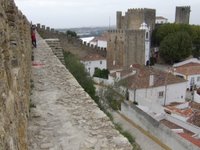 three-foot wide stone wall around the old city. Emma and Cathy are sure-footed as mountain goats but Akiva takes after David, and was more comfortable holding Cathy’s hand at the highest, narrowest spots, while David made sure everything was working well on the ground by ordering another cup of coffee. David should have considered a hot chocolate since Óbidos was putting up tents and banners in preparation for the Nestlé European International Chocolate Fair the following week – we could have gone if we had taken our trip in Week 45.
three-foot wide stone wall around the old city. Emma and Cathy are sure-footed as mountain goats but Akiva takes after David, and was more comfortable holding Cathy’s hand at the highest, narrowest spots, while David made sure everything was working well on the ground by ordering another cup of coffee. David should have considered a hot chocolate since Óbidos was putting up tents and banners in preparation for the Nestlé European International Chocolate Fair the following week – we could have gone if we had taken our trip in Week 45.
We extended our stay in Nazaré for one night – Emma wanted to stay the whole week, and we were all sympathetic! On our last night, Cathy and David left Emma and Akiva at the B&B to enjoy their favorite meal of junk food and TV. As good as the fresh fish was, we went looking for something different for dinner in Nazaré. We decided we wanted to find pasta, but the first 10 restaurants or so had identical menus: sardines, grilled fish, hamburger, and Southeast Asian shellfish (shrimp, mussels, and crabs are almost entirely imported to
The next morning we set off inland and east towards the town of 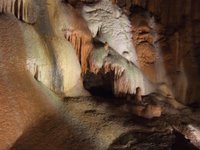 are apparently many caves dotted throughout the country. The caves we went to were discovered in the 1940s and developed for tourism, with stairs, handrails, lights, an emergency telephone system, and an elevator. The parking lot looked as if it could hold a lot of tour buses, but we were the only people escorted through the caves by a young man who only spoke Portuguese. We went to the bottom of one enormous cavern – looking up it was larger than the largest church in
are apparently many caves dotted throughout the country. The caves we went to were discovered in the 1940s and developed for tourism, with stairs, handrails, lights, an emergency telephone system, and an elevator. The parking lot looked as if it could hold a lot of tour buses, but we were the only people escorted through the caves by a young man who only spoke Portuguese. We went to the bottom of one enormous cavern – looking up it was larger than the largest church in
 Cathy likes to find places a little off the beaten path – and although both the caves and
Cathy likes to find places a little off the beaten path – and although both the caves and 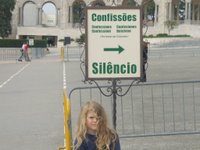 sized church plaza, built to hold the worshipers. We parked a few blocks from the main church and walked past countless stores selling countless statuettes of saints, the holy family, and the children who saw the miracle. Stores also sold six-foot long candles and plastic body pieces – ears, arms, breasts, etc. – both presumably to be carried as believers went to be healed. In the giant church plaza there was a huge roped-off area for a confessional with wheelchair access and a sign which we made Akiva read that said “Silençio” in large letters.
sized church plaza, built to hold the worshipers. We parked a few blocks from the main church and walked past countless stores selling countless statuettes of saints, the holy family, and the children who saw the miracle. Stores also sold six-foot long candles and plastic body pieces – ears, arms, breasts, etc. – both presumably to be carried as believers went to be healed. In the giant church plaza there was a huge roped-off area for a confessional with wheelchair access and a sign which we made Akiva read that said “Silençio” in large letters.
In Tomar we visited the oldest medieval Jewish synagogue in 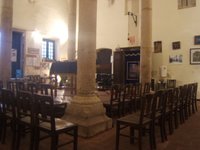 Sephardic style synagogue, with an eclectic assortment of Judaica donated from around the world, including a tallit from
Sephardic style synagogue, with an eclectic assortment of Judaica donated from around the world, including a tallit from
There was a river running through Tomar, and we stayed in a hotel right in the center of the city, indeed in the middle of a park surrounded by a moat (with one small bridge to enter the park). We had a lovely Chinese take-out dinner and yet another excellent bottle of wine sitting on our balcony, looking out over the park. That evening we saw a raucous and long parade of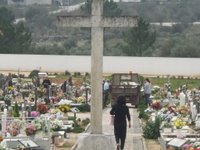 teenagers dressed in odd costumes, chanting and singing "When the Saints Go Marching In." It was Halloween, and we were pretty sure that it was something to do with All Saints' Day on November 1, but it turned out to be a hazing ritual for the freshman from the local university. Stores closed on All Saints' Day, a national holiday, and we saw amazing flowers at a cemetery in
teenagers dressed in odd costumes, chanting and singing "When the Saints Go Marching In." It was Halloween, and we were pretty sure that it was something to do with All Saints' Day on November 1, but it turned out to be a hazing ritual for the freshman from the local university. Stores closed on All Saints' Day, a national holiday, and we saw amazing flowers at a cemetery in
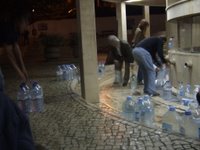 Cathy found out that there were some famous spas a bit north of Tomar, so we headed off to Luso. The hotel we called said the spa was closed that day, but would be open the following day, so we reserved a room, used the swimming pool, ate on the balcony, saw a funeral procession, listened to recorded church bells (which made us homesick for the church bells in Lund), and awaited Cathy’s day in the spa. That night, Cathy and David walked through the tiny town of
Cathy found out that there were some famous spas a bit north of Tomar, so we headed off to Luso. The hotel we called said the spa was closed that day, but would be open the following day, so we reserved a room, used the swimming pool, ate on the balcony, saw a funeral procession, listened to recorded church bells (which made us homesick for the church bells in Lund), and awaited Cathy’s day in the spa. That night, Cathy and David walked through the tiny town of
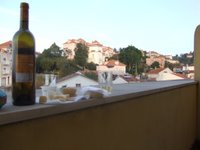 The next morning, Cathy happily went to the spa, but it was closed. In fact it was closed for the winter. Why did the hotel staff say it was open? Well, we hope it wasn’t just to get our business for a night, but at the same time, there wasn’t much of a language barrier in this case. We decided to hit the swimming pool once more, but there was no sign of Emma’s swimsuit, which we had left to dry on the balcony. Hmmm, there was a big wind the night before. We talked to the staff since there were balconies below ours. We don’t know quite how, but Emma’s swimsuit mysteriously ended up back on our balcony at some point.
The next morning, Cathy happily went to the spa, but it was closed. In fact it was closed for the winter. Why did the hotel staff say it was open? Well, we hope it wasn’t just to get our business for a night, but at the same time, there wasn’t much of a language barrier in this case. We decided to hit the swimming pool once more, but there was no sign of Emma’s swimsuit, which we had left to dry on the balcony. Hmmm, there was a big wind the night before. We talked to the staff since there were balconies below ours. We don’t know quite how, but Emma’s swimsuit mysteriously ended up back on our balcony at some point.
Upon finding the spa was closed, everybody – the spa staff (there behind closed doors cleaning or the winter), the tourist bureau, the hotel staff – said that we could try Curia, a nearby spa town that didn’t close in winter. They thought. All they could really tell us was the route to Curia, which was apparent in any case. At Curia, Cathy got a computerized-electronic hot water massage (because other activities were booked for days ahead), and the whole place felt more like a hospital than a spa. Oh well, Cathy misses the Korean spa near
We spent our final two days in and around
